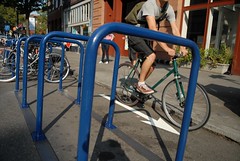As we’ve been covering with regularity in recent weeks, the City of Portland Bureau of Transportation has been busy installing new on-street bike parking facilities. Known as “bike corrals,” they have proven to be very popular with the community and with business owners.
Each time we cover a new installation, many people wonder how a specific spot was chosen over another. I’ve talked to several business owners that have been frustrated at the time it takes to get one and/or by not even being considered for one at all.
At Biwa in Southeast Portland, owner Gabe Rosen has resorted to having customers fill out comment cards and sign up for an email list to petition the City to put one in front of his restaurant.
PBOT installed the first bike corral in September of 2004 (in front of Fresh Pot on N. Shaver at Mississippi). They went two years before installing another one while they worked on funding, policy, and design issues. With all that worked out, since last fall PBOT has put in 15 corrals throughout the city, with the two most recent ones just completed yesterday.

According to the PBOT staffer in charge of the program, Sarah Figliozzi, they currently have over 60 businesses requesting corrals and they have 150 location suggestions on file (mostly from comments received at Bike Master Plan open houses).
Businesses are clamoring for these facilities for many reasons; they improve the pedestrian space by getting bikes out of the way, they increase parking capacity, they improve visibility, and so on. In addition, PBOT now has funding to pay for the facilities, a change from previous policy that required business owners to foot the bill (about $2-3,000) themselves.
Another policy change that Figliozzi says they’ve made is that they no longer serve requests on a first-come, first-serve basis. Now, she and PBOT staff are tackling entire commercial corridors at the same time. Figliozzi says this new approach takes more time, but makes her planning efforts “more robust and efficient.”
Figliozzi has dealt with her share of disappointed and impatient business owners, but she feels that PBOT has an obligation to understand the entire business district’s transportation needs on a whole, instead of just responding to individual requests.
The commercial corridors Figliozzi is currently working on are SE/NE 28th Ave. between Glisan and Stark and NE Albert Street.
So, if you want a bike corral and you’re on a commercial corridor, PBOT then assesses the bike parking demand. Figliozzi says this isn’t as easy as it seems.
“Demand needs to be apparent,” she wrote to me via email, “but latent demand is also a factor.” On that note, she pointed out a recent corral that went in at Dragonfly Cafe in Northwest Portland. There was only one staple rack in place, but after the corral went in customers now fill 12 bike parking spaces.
But Figliozzi warns that latent demand “can’t be overly emphasized.” She said she gets many requests from businesses with no bike parking whatsoever and show no obvious existing demand. Figliozzi says it’s “fantastic” to see this type of enthusiasm, but that it’s also, “not justifiable to use City funding on these locations where one or two racks will meet demand.”
Figliozzi says that in the future, she hopes the City will have the staffing resources (needed to install the racks) to be able to offer businesses the option to pay for corrals themselves at low demand locations.
Once there’s a clear demand, the City moves forward with the request (and as requests pile up, Figliozzi says so does the lag time in processing them). A key part of the process is to get a signed “Maintenance Agreement”. The business adjacent to the bike corral must ensure that the facility stays free of debris. It’s an important consideration, because once the corrals go in, the City can no longer sweep the street.
Figliozzi has been making the rounds to neighborhood and business associations to explain the process and the benefits associated with the corrals. She also says PBOT has finally put more information about on-street bike corrals on their website.
Stay tuned for photos and more coverage as bike corral installation season remains in full swing.


